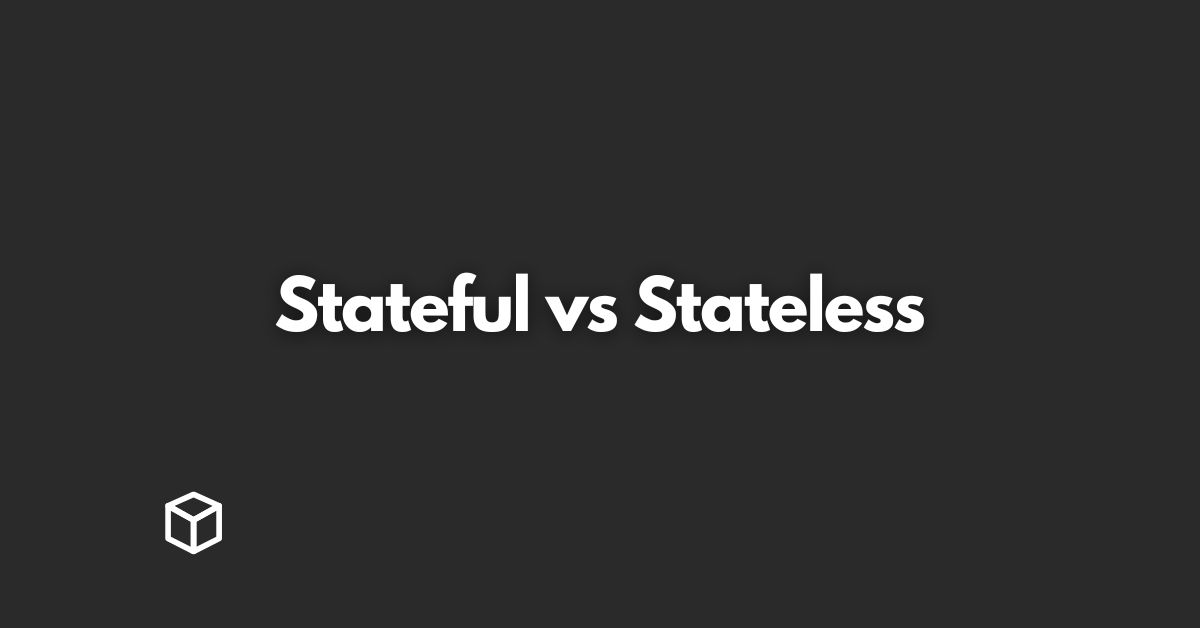In the world of software development, the terms “stateful” and “stateless” are often used to describe different types of systems.
Understanding the difference between the two is crucial for developing efficient and effective software.
In this post, we will define stateful and stateless systems, explain how they work, and discuss when to use them.
Stateful Systems
A stateful system is one that maintains a record of the interactions it has with its environment.
This means that it stores information about the current state of the system, and uses that information to make decisions about how to respond to new requests.
One example of a stateful system is a relational database. In a relational database, data is stored in tables and can be queried using SQL.
When a user makes a request to the database, the database uses information about the current state of the data to decide how to respond to the request.
Advantages of Stateful Systems
Stateful systems have several advantages. One of the main advantages is that they allow for the storage and retrieval of data.
This is important for applications that need to keep track of user information, such as an e-commerce website that needs to remember what items a user has added to their shopping cart.
Another advantage of stateful systems is that they can make decisions based on the current state of the system.
For example, a stateful system can use information about the current state of a user’s account to decide whether to allow or deny a request to make a purchase.
Disadvantages of Stateful Systems
Despite their advantages, stateful systems also have several disadvantages. One disadvantage is that they can be more complex than stateless systems.
This is because stateful systems need to keep track of the current state of the system, which can make the code more difficult to write and maintain.
Another disadvantage of stateful systems is that they can be more prone to data loss.
This is because stateful systems rely on information about the current state of the system, which can be lost if the system crashes or there is a power failure.
Stateless Systems
A stateless system, on the other hand, does not maintain a record of the interactions it has with its environment.
This means that it does not store information about the current state of the system and does not use that information to make decisions about how to respond to new requests.
An example of a stateless system is a RESTful web service. In a RESTful web service, each request contains all the information that the server needs to process the request.
The server does not rely on information about the current state of the system to decide how to respond to the request.
Advantages of Stateless Systems
Stateless systems have several advantages.
One of the main advantages is that they can be more scalable than stateful systems.
This is because stateless systems do not need to keep track of the current state of the system, which means that they can handle more requests at the same time.
Another advantage of stateless systems is that they are more fault-tolerant.
This is because stateless systems do not rely on information about the current state of the system, which means that if one part of the system fails, it does not affect the rest of the system.
Disadvantages of Stateless Systems
Despite their advantages, stateless systems also have several disadvantages. One disadvantage is that they do not allow for the storage and retrieval of data.
This is because stateless systems do not keep track of the current state of the system, which means that they cannot remember information about the user or previous interactions.
This can make it difficult to implement certain features, such as personalization or user tracking.
Another disadvantage of stateless systems is that they cannot make decisions based on the current state of the system.
This means that they cannot use information about the user or previous interactions to decide how to respond to a request.
This can make it difficult to implement certain features, such as access control or fraud detection.
Use Cases
When deciding whether to use a stateful or stateless system, it is important to consider the specific requirements of the application.
For example, an e-commerce website that needs to keep track of user information and make decisions based on the current state of the user’s account would likely be better served by a stateful system, such as a relational database.
On the other hand, a web service that needs to handle a high volume of requests and is not concerned with remembering information about the user or previous interactions would likely be better served by a stateless system, such as a RESTful web service.
Conclusion
In conclusion, stateful and stateless systems are two different types of systems that have their own advantages and disadvantages.
Understanding the difference between the two is crucial for developing efficient and effective software.
While stateful systems are better suited for applications that need to keep track of user information and make decisions based on the current state of the system, stateless systems are better suited for applications that need to handle a high volume of requests and are not concerned with remembering information about the user or previous interactions.




